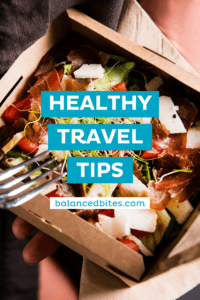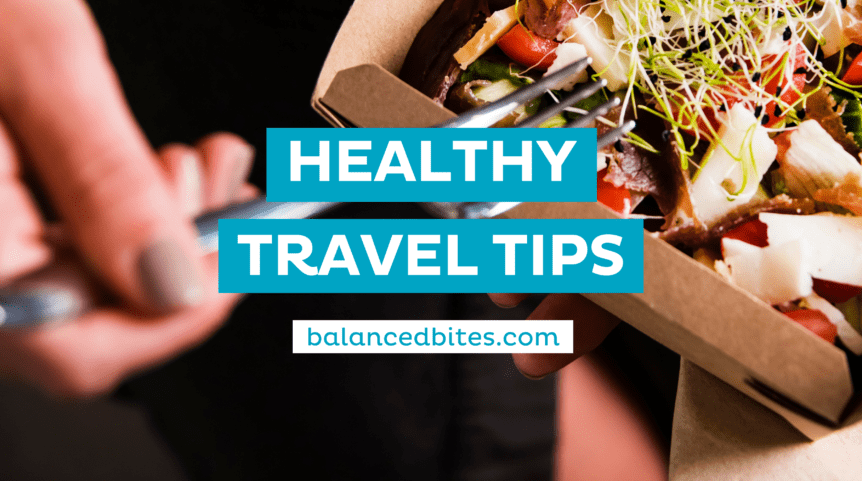As many of you may know, I have a lot of first-hand experience with how tricky it can be to find healthy, gluten-free friendly food while traveling.
If you don't already follow me on Instagram, I recommend jumping over there for real-time/live posts from different places. I also have tagged my travel photos: #PracticalPaleoTravel and am also starting to use city-specific tags as well: #PracticalPaleoTravelLA, #PracticalPaleoTravelPDX, #PracticalPaleoTravelSF, #DocandFlipsinMaui.
For city-specific guides, check out the following posts:



With just a little bit of forethought and planning, you'll be able to travel while eating gluten-free with ease!
Here are my Top Healthy Travel Tips, let me know any tips you have in the comments below!
Tips for before you go.
About 1-2 weeks ahead, think about any special travel food items you may want to order online like jerky, bars, or dried fruits.
Take advantage of travel review sites like Trip Advisor and Yelp. Reading reviews ahead of time and searching for popular terms like gluten-free, organic, grass-fed, and even farm-to-table can help take the stress out of deciding where to eat while you're on the road.
At hotels, resorts, and on cruise ships, don't be afraid to ask questions and be specific about how to customize your experience. The staff is there to make your stay enjoyable, and will be happy to accommodate you. Of course, calling ahead to communicate any special needs also helps, but on-the-spot requests for gluten-free meals, for example, can typically be catered to pretty easily.
Request a mini-fridge in your hotel room. If necessary, explain that you have food allergies. Every hotel has them for medical purposes, so calling or making the request ahead of time is your best bet. Alternatively, book a room in a suites/extended-stay venue that has a kitchenette. These are becoming more and more popular/available and are not necessarily more expensive than other types of hotels.
Or, better yet (and this is actually my BEST tip), book a room that has a full kitchen. Most of these rooms include a full-sized refrigerator, 1-2 burners, pots and pans, a toaster, a coffee pot, utensils, a cutting board, and more. Some common chains are Residence Inn and Homewood Suites.
Tips for the trip.
Use a cooler bag with a reliable/leak-proof ice pack to keep foods fresh in your hotel room. Pack your ice pack in your checked luggage wrapped in extra zip-top bags so that it doesn't leak.
Pack foods in tall/narrow containers that stay upright and won’t spill. Rinse and re-use containers you bring or that you purchase with food in them along the way.
Use lots of small and large zip-top bags. They can not only hold food and prevent spills, but they can be re-used to hold ice from an ice machine or messy trash from your travels.
Find a grocery store. Prior to your departure date, search online to locate a grocery store like Whole Foods Market, Trader Joe’s, or other organic grocers or natural food co-ops at your destination and stock up when you arrive.
Keep extra protein and fat sources on hand like jerky and nuts or nut butter packets in the event of a flight delay. They’re lightweight, so it’s easy to pack extra.
In a pinch, very dark chocolate, nuts, and/or trail mix can work as healthy snacks and are often a healthier choice than any protein bars or other snacks available.
Dining out tips.
You can usually find salads with meat at airport food vendors. Simply remove the unwanted ingredients, and ask for lemons to use for dressing with the olive oil you have brought with you.
Bunless burgers can often be made to order even if they're not on the menu – which they usually aren't.
Bring sea salt and organic black pepper in small containers so that you can season up any bland travel-food with healthy spices. I like Redmond Real Salt, and I refill their salt shakers with pepper for my trips.
Always think ahead. You'll never be sorry you carried some extra snacks, but a delay on the tarmac or an unexpected, extended time without food handy will leave you hungry and possibly scavenging for less healthy choices. Err on the side of packing a bit more than you need to keep yourself well prepared.
Air travel and airport tips.
Keep small, 2-3-ounce spill-proof containers around for liquids, if possible, make sure the volume size of the container is stamped on it so that the TSA can see it easily, though tiny bottles usually are fine even up to 4oz I've found. I highly recommend carrying extra-virgin olive oil this way for use on salads, etc.
Use clear liquid containers for semi-solid items like guacamole so that they can be viewed easily. I've heard that freezing a small bottle of water the night before going through TSA in an airport will allow it to pass through since it'll be in a solid state, but I can't confirm this because I haven't tried it. I have, however, noticed the price of bottled water seems less insane that it was in the past, so grabbing water before a flight may not be so crazy at this point.
Dry foods are perfectly acceptable in carry-on bags, don't hesitate to bring food on-board with you. This even means leftovers from dinner, a salad, etc. Only liquids or semi-liquids are ever in question.
Take advantage of frequent flyer benefits such as “club rooms” in airports. For example, The United Club often stocks whole pieces of fruit like apples and bananas as well as organic tea bags that can be used in-flight with hot water available. The options for Paleo aren't amazing, but they exist and are free if you have access – use them!
Bring a refillable water bottle. While you can certainly buy bottled water once you're through security, you can easily refill a bottle in any airport. They all have water fountains, and many even offer filtered water.
Cruise ship travel tips.
You won't likely have a mini fridge on the ship, but rather a “beverage cooler.” This means that most food won't be chilled adequately to low food safety temperatures of 40 degrees F or below if stored in them. While some foods will be okay in these coolers overnight or for a short period of time, most won't.
 You may bring large bottles of liquids onto a cruise ship (provided you had them in a checked bag for the air travel, or purchased them after your flight to the port). There are typically limitations on how much water and alcohol you can bring aboard, so check with your individual cruise line before you take the trip.
You may bring large bottles of liquids onto a cruise ship (provided you had them in a checked bag for the air travel, or purchased them after your flight to the port). There are typically limitations on how much water and alcohol you can bring aboard, so check with your individual cruise line before you take the trip.
Many ships will offer you a gluten-free menu, but they require a long lead time for notice (several weeks to a couple of months). Check your booking information and be sure to call or email the cruise line appropriately if you need to make this request. While most of the staff on the ship can accommodate gluten-free diets easily when they're a dietary preference, if you have Celiac disease and need to be even more diligent about this, a contact ahead can make all the difference for you.


Comments 10
Some of these tips are okay, but please do more research on how things like “trail mix”, specifically dried fruit and nuts (both of which contain mold) and the awful combination they create for your gut overall. I recently learned all about this during a nutritional retreat and there is information out there. The nutritionist lecturing at the retreat called trail mix “the perfect storm” for your digestive system. Eating “Paleo” shouldn’t ever sacrifice gut health – it should, if anything help make that environment better! I am grain-free so many of those “gluten-free” options that are offered at restaurants are totally out for me – besides more than likely containing rice or corn, they are usually loaded with sugar and bad trans fats/chemicals (that I also avoid). You are right that it isn’t easy to travel eating “Paleo”, but there is much more involved when you factor in wanting to actually maintain a healthy gut! I will be taking a short trip in a couple of weeks and will probably be living on avocados! LOL. Thanks for the article –
I concur. I cant eat dried fruit or nuts OR seeds! I have to follow the Paleo RX diet as outlined by Jack Kruse ..I’ve been taking bone broth soup to work but its not an option when you have to carry stuff about!!
Peccamon? Has anyone heard of this? Its made from organ meat and sounds good but I’ve not got that far yet. Try paleomom.com for more on AIP diet. Autoimmune Paleo is quite hardcore, but it works. I tend to fall off the wagon everytime i set foot outside the house, but its getting easier!
Good suggestions, thanks.
Phoebe
Author
glad to help
This is a very helpful article. Being new to Paleo diet lifestyle, I could try this on my next trip in few weeks.
Pingback: Weekly sparks
Do I need to put my individual packs of nut butter in my quart bag to go through security?
If you accept someone’s offer to host you, make sure they are fully aware of your needs. Use your judgement and don’t stay with people who do not understand this. I suggest having them leave some pots and pans just for you to cook your meals with and clean with a separate sponge to avoid contamination with foods you don’t eat.
Eric@MapDestinations
Pingback: Episode 37: NYT best-selling Paleo cookbook author Diane Sanfilippo on easy recipes, travel, and food photography | Reverse Diabetes Coach
Pingback: Wellness Roundup: Staying Healthy on the Road - our food fix
Pingback: Paleo & AIP Travel Round Up - Food and Sunshine